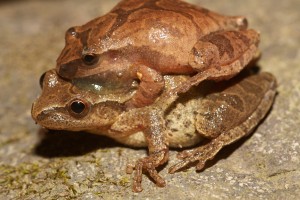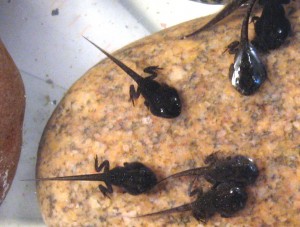An Introduction to Spring Peepers

Spring Peeper Basics
As surely as crocuses and daffodils mark the arrival of spring, so too do the calls of spring peepers (Pseudacris cruicifer). If you live in the Eastern US you're hearing the northern spring peeper (Pseudacris cruicifer crucifer), and if you live in the Southeastern US (roughly from Texas and Georgia to Florida, along the Gulf coast) then you might be hearing the southern spring peeper (Pseudacris cruicifer bartramiana). Both subspecies belong to a genus of frogs in the family Haylidae (hay-la-day), which is commonly known as the "chorus frog" family. These guys can belt it out! There are mountain chorus frogs, upland chorus frogs, striped chorus frogs, and more. Remember the singing frog from Bugs Bunny? Chorus frogs, and spring peepers, would qualify as champs up there with this guy.
For this post I'm going to focus on the most common spring peeper in our area, the northern spring peeper. First, what do they look like? They're small. We're not talking about giant bullfrogs here. Peepers range in size from 25-38 mm (1-1.5 inches), and they range in weight from around a dime (3 grams) to a quarter (5 grams). What makes them unique is their body markings.
All peepers have an X on their back (X marks the spot!). Their Latin name "cruicifer" means cross-bearing. In botany the term cruiceferous means an arrangement of petals or leaves in a symmetrical pattern. Peepers can range in color from tan to grey, or even dark brown. They are great at hiding in leaf litter and on trees because they look like bark or woody debris. Finding one that is sitting still and not calling is nearly impossible!

They also have dark stripes on their legs and a dark line between their eyes. Males are usually smaller and darker than females, and have a slightly darker throat, because they have a vocal pouch below their chin for singing. This flap can become darker during the breeding season when they are calling. (No accounting for taste! Girl frogs find this incredibly sexy!)
All peepers have a light belly, ranging from tan to cream color. Peepers are also great climbers. They have a flat toe pad on the end of each toe that allows them to grip onto bark and slick plant leaves. They can also change their skin tone slightly to match the bark and leaves that they're sitting on.
DIET AND HABITS
Spring peepers are amphibians, so they need marshy and damp areas near ponds and swamps to grow and reproduce (temporary or permanent ponds and pools will do nicely). Despite the fact that peepers are good climbers, they tend to stay on the ground, buried in nice moist leaf litter and hunting for small insects to eat. This includes ants, spiders, flies, beetles, grubs and more. If they climb, it's usually for calling purposes (Oh, Romeo!).

Breeding occurs from early spring to June or even into late June. One male may mate with many females. Here's your fun term for the day, they mate through amplexus (am-pl-ex-us). The male holds onto the female in a bear hug where he's on top, and externally fertilizes the eggs of the female as she lays them. You can read all about amplexus and body size of peepers in this fun paper from the Journal of Ecological Research, 13, 28-33. I female can lay between 700-1,300 eggs in one season! No 'family values' here, as there's no parental care after the eggs are laid. Mom hops off on her merry way, and dad continues to search for amplexus partners after mating. Tadpoles hatch in a few days to a few weeks (depending on temp). They feed on algae, decaying organic debris/leaf litter, and micro-organisms such as plankton and worms. They can remain as tadpoles from 45-90 days.

As adults most peepers only live a season or two, maybe three years at most, but that's pushing it. Adult peepers hibernate in winter in mud and leaf debris around ponds. Much like wood frogs, they have a natural built-in antifreeze that prevents them from freezing solid in winter. Their cells expel as much water as possible, and sugars (glycogen) in their blood protect their internal organs and keep their bodies going through the winter.
SINGING
Despite their diminutive size, peepers are the able to really belt out their songs. You can read my previous post on how frogs hear and make sound if you'd like to know more. These guys are great at using their natural surroundings to amplify their sounds too. They position themselves against bark, stems, and leaves in a way that makes them sound like they are as big as a bull frog and right next to you, even though they may be feet away! I always feel like I've scored a major accomplishment if I can sneak up on one singing, they are super hard to see, they go quietly at the drop of a hat, and are impossible to see sitting still and not singing!
It's hard to describe a peepers call as anything other than a series of high pitched peeps. Their call makes me think of someone jumping up and down on a trampoline really fast and peeping. Here's a video of northern spring peepers calling:
Just so you can hear the difference, here's the southern spring peeper:
Males have the funny habit of singing in trios (three frogs all belting it out together). The largest male starts and then sequentially they peep and at different pitches. These duets allow females to choose from a nice selection of harmonies. There is a clear hierarchy in who is the chorus leader and in the calling in the trio. Many other chorus frogs do this too, some form duets, and even quartets! Anything to impress the lady frogs! Mate selection is usually based on size, which influences call and status in the trio. The louder the "peep" the more likely a male is to mate.
GOOD NEWS
Peepers are an important food source for salamanders, snakes, birds. Dragonflies love to eat tadpoles, but frogs are also on the menu for spiders and even bats.
Unlike other frog species, spring peepers aren't experiencing any major declines in their populations. They are doing quite well. They also do not seem affected by the fungal virus and deformities that other frogs are subject to.
Regardless of whether you think their calling is a loud nuisance or a fond reminder of spring, peepers are an important part of their ecosystems and their romantic trilling will always let you know they are there!

